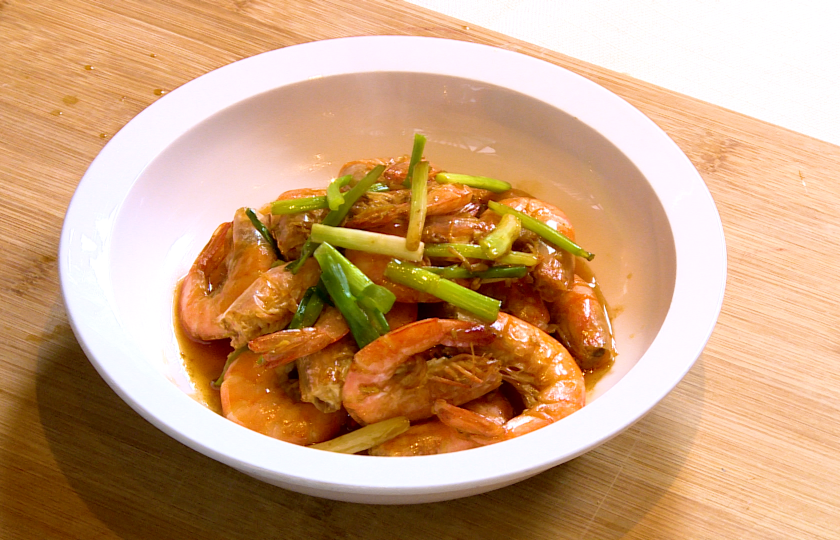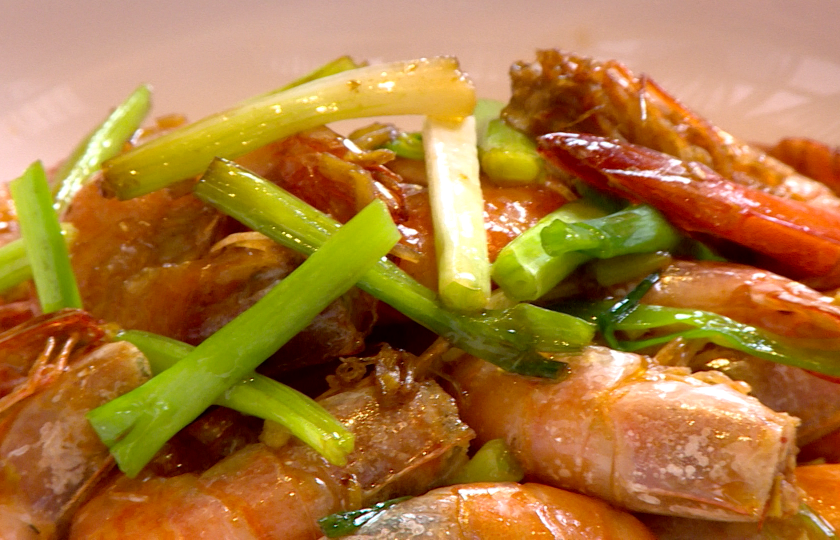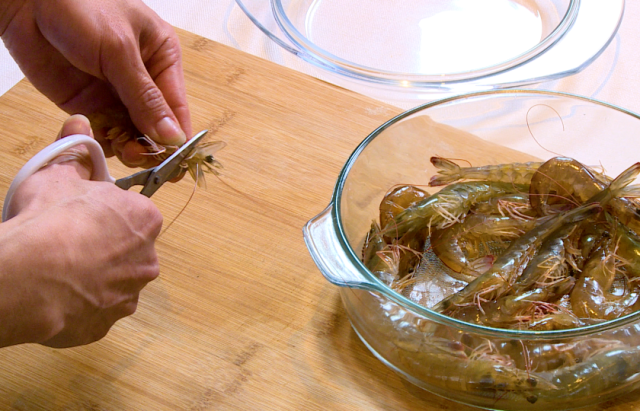Delicious Braised Prawns Recipe


Dear friends who are about to entertain guests, pay attention! Braised prawns are undoubtedly the dazzling stars on the dining table. The prawns themselves have plump and delicious meat. After being braised, they have a rich and mellow taste. Whether it is used for business banquets to show elegance or to add a cheerful atmosphere at family gatherings, this delicious dish can make both guests and hosts happy and fully demonstrate your enthusiasm and sincere intentions.
Ingredients and Substitutions
To make this dish of braised prawns, you need to prepare the following materials:
Main ingredients
Prawns: As the core ingredient of the dish, the meat is tender and brings a delicious taste.
Accessories
Ginger: Plays the role of removing fishy smell and enhancing fragrance, giving the dish a unique ginger aroma.
Scallions: Can not only remove the fishy smell of prawns but also add a touch of scallion fragrance to the dish and serve as decoration.
Seasonings
Oil: Not only helps with frying but also enables prawns to be heated evenly and releases an enticing fragrance.
Salt: The basis of seasoning, it can highlight the deliciousness of prawn meat and add a salty and fragrant flavor.
Cooking wine: It has the function of removing fishy smell and relieving greasiness and enhancing the flavor level of prawns.
Sugar: Brings sweetness and subtly balances the taste, which is the unique flavor of braised dishes.
Soy sauce: Adjusts the color and adds salty and umami flavors, making the dish's color and taste more abundant.
Substitutions
When ginger is in short supply, 2-3 grams of ginger powder can be used as a substitute, but the ginger aroma will be slightly weaker and can be adjusted according to personal taste.
If there is no cooking wine, 8-10 milliliters of white wine can be used as a substitute. Pay attention to controlling the dosage to avoid excessive wine taste affecting the overall flavor.
When there is no soy sauce, light soy sauce and dark soy sauce can be mixed in a ratio of 2:1 and 4-5 milliliters can be used to approach the ideal color and taste.
If there are no scallions, 15-20 grams of shredded onions can be used as a substitute. Although the flavor is slightly different, it can also play a role in removing fishy smell. Adjust the dosage according to personal preference.

What is the best way to cook shrimp
Steamed shrimp can best retain freshness and nutrition. First, wash the shrimp, cut open the back of the shrimp and remove the shrimp thread. Put it on a steaming plate, sprinkle shredded ginger, scallions, a little salt and cooking wine. When the water in the steamer boils, steam it on high heat for 8-10 minutes (adjust according to the size of the shrimp). After it is cooked, pour out the juice, pour hot oil, and add light soy sauce, vinegar and other seasonings as needed.
Boiled shrimp is simple and convenient and shows the original taste. Wash the shrimp and cut off the whiskers and feet. Add water, ginger, scallions, cooking wine and salt to the pot and bring to a boil. Put the shrimp in and cook for 2-3 minutes until it turns red and is fully cooked. Take it out and serve with dipping sauce made of minced garlic, light soy sauce, vinegar, sesame oil, sugar, etc. for added freshness.
Braised prawns in oil have a bright red color and rich flavor. Wash the shrimp and deal with the shrimp thread and cut open the back. Pour oil and fry the shrimp until both sides are red. Add ginger, scallions and garlic and stir-fry until fragrant. Then add cooking wine, sugar, salt and light soy sauce. Add a small amount of water and simmer for several minutes to absorb the flavor. Collect the juice on high heat. The shell is crispy and the shrimp meat is firm, which is just right for a meal.
What tool is used to remove the shrimp thread
Toothpicks are the most common and convenient to use. Pick up the shrimp and insert the tip of the toothpick into the second or third section of the back of the shrimp. Gently pick it up. When you see the black shrimp thread, pull it out steadily. If it breaks in the middle, you can pick it again from the tail to get out the remaining part. Every family has it. It is easy to use and does not damage the shrimp meat.
A special shrimp thread picker is more efficient. It has a sharp tip and a small hook. Insert it into the back of the shrimp. The hook hooks the shrimp thread and lifts it up, and it can be taken out completely. Some have serrations and can also cut open the back of the shrimp to help the seasoning absorb. It has obvious advantages when dealing with a large number of shrimp.
A fine needle is also possible. The operation is similar to that of a toothpick. Insert it into the back of the shrimp to find the shrimp thread. Pass it from below and then pick it up. Its tip is extremely fine. When dealing with small shrimp or difficult-to-pick shrimp threads, the operation is more accurate and can reduce the degree of damage to the shrimp meat. You can choose tools according to your personal habits and the amount of shrimp.
How to control the heat when stir-frying shrimp
When stir-frying fresh shrimp, heat the pan with medium heat and add oil. When the oil is hot until it smokes slightly (about 150-160℃), put the shrimp in to prevent the outer skin from being burnt and the inside from being undercooked. Then turn to high heat immediately to quickly lock in the moisture and make the shrimp meat more tender. Stir-fry quickly for 1-2 minutes until the shrimp turns red and is about to be cooked. After changing color, turn to medium heat. At this time, add seasonings such as salt, cooking wine and light soy sauce, and stir-fry for 30 seconds to 1 minute to help it absorb the flavor and avoid burning the seasonings. Before serving, turn to low heat and stir a few times to keep the shrimp meat tender.
Stir-frying big prawns is different. At first, heat the pan with high heat and add more oil. When the oil is hot (about 180-200℃), put the shrimp in to quickly make the shell crispy. Fry each side for 1-2 minutes until it turns red and slightly charred, then turn it over. After frying both sides, turn to medium heat, add seasonings such as ginger and garlic, and stir-fry for 1-2 minutes to absorb the flavor. If you want it to be more flavorful, add a small amount of water and simmer on low heat for 2-3 minutes. The shrimp meat absorbs the soup and is still as tender as before. Finally, collect the juice on high heat and the soup wraps the shrimp and then take it out of the pan.
INGREDIENTS
Main Ingredients
-
·600g prawns
Additional Ingredients
-
·10g ginger
-
·20g scallions
Seasonings
-
·30ml oil
-
·5g salt
-
·10ml cooking wine
-
·5g sugar
-
·5ml soy sauce
COOKING STEP
Step 1
Wash the prawns carefully, remove the shrimp eyes, keep the shrimp heads and cut off the shrimp feet. Drain the excess water and set aside.

Step 2
Cut the ginger into fine minced ginger. Cut the scallions into sections about 2 centimeters long, and then divide the scallions into two equal parts.

Step 3
Pour 15 to 20 milliliters of oil into the pot and heat it patiently on medium heat.

Step 4
When the oil is hot until it smokes slightly, pour in the prawns and quickly turn to high heat to fry quickly until the whole body of the shrimp turns red and the shell is crispy.

Step 5
Sprinkle minced ginger into the pot and stir-fry quickly to stir-fry out the rich ginger fragrance.

Step 6
Pour in 10 milliliters of cooking wine to remove fishy smell and enhance fragrance. Then add 2.5 grams of salt and 2.5 grams of sugar to season and enhance freshness accurately.

Step 7
Put one part of the scallions into the pot, and then add 5 milliliters of soy sauce. Stir evenly to give the dish a beautiful color.

Step 8
Pour 200 milliliters of clear water into the pot, cover the pot and simmer on medium heat for 2 minutes to let the prawns fully absorb the flavor of the soup.

Step 9
Continue heating until the soup in the pot thickens and becomes less and tightly wraps on the surface of the prawns. Sprinkle the other part of scallions for decoration and take it out of the pot and plate it.

More recipes worth trying
Simple Shrimp Fried Rice Recipe
Delicious Homemade Braised Chicken Wings
Salt and Pepper Chicken Wings Air Fryer Recipe
Tofu With Ground Pork Oyster Sauce Chinese
Recipe Variations
Cheese-baked Shrimp: Prepare fresh shrimp, mozzarella cheese, butter, etc. Wash and process the shrimp, pick out the shrimp thread, and marinate with salt, cooking wine and black pepper for 10 minutes. Melt butter in a pot and stir-fry minced garlic to make garlic sauce. Arrange the marinated shrimp on a plate, pour the sauce and sprinkle cheese. Bake in an oven at 200℃ for 10 - 12 minutes until the cheese melts and turns golden, and the milky fragrance permeates the tender shrimp meat.
Thai Curry Shrimp: Prepare fresh shrimp, onions, potatoes and Thai red curry paste, etc. Process the shrimp well and cut the vegetables into pieces or shreds. After the oil is hot, stir-fry ginger, garlic and lemongrass until fragrant. Add curry paste and stir-fry until red oil comes out. Stir-fry onions until soft. Add potatoes and carrots and stir-fry. Add water and simmer until the vegetables are soft. Put in the shrimp and cook until it changes color. Pour in coconut milk and fish sauce and squeeze lime juice. The spicy and sour curry wraps the shrimp and has a unique flavor.
Typhoon Shelter Style Stir-fried Shrimp: Prepare big prawns, breadcrumbs, etc. Wash the shrimp, marinate it and then wrap it with starch. Mince garlic and fry until golden and take it out. Fry the shrimp in 70% hot oil until the shell is crispy and take it out. Leave some oil and stir-fry dried chili peppers. Add breadcrumbs and stir-fry until yellow. Pour in garlic and shrimp and add sugar and stir well. The shrimp is crispy, the breadcrumbs are brittle and the garlic fragrance is overflowing.
Why are boiled shrimp hard
First, overcooking. Shrimp meat is rich in protein. Long-term high temperature will cause excessive denaturation. Just like a rubber band is overstretched and loses elasticity and becomes stiff. It will also cause a large amount of moisture to be lost. If it exceeds 10-15 minutes (depending on the size of the shrimp), the shrimp meat will easily become dry and hard.
Second, too high cooking temperature. Boiling shrimp with high heat. The protein on the outer layer of the shrimp meat quickly solidifies into a hard shell, which hinders the internal moisture from dissipating. The internal pressure increases, aggravating the protein denaturation and making the whole shrimp meat lose its fresh and tender texture.
Third, affected by shrimp varieties and freshness. For example, the meat of some deep-sea shrimp is originally firm. After boiling, it will be even harder. For stale shrimp, the muscle tissue has decomposed and the protein has changed. During cooking, it cannot maintain the freshness like fresh shrimp. After cooking, it will naturally be harder.
FAQs:
Second, it concerns the texture. When fresh shrimp is just cooked, the meat is firm and elastic. For medium-sized prawns, after being stir-fried, the shape is complete. When picked up, it will bend slightly. This is caused by the contraction of protein after being heated, and the taste is fresh and tender. If you pursue crispiness, continue to stir-fry dried shrimp, etc. until the shell is dehydrated and hardened and makes a "rustling" sound. The shell is hard and crisp, and the meat is slightly dry but has a unique flavor.
Third, look at the release of flavor. When shrimp is cooked, the umami flavor is fully released and a strong shrimp fragrance fills the kitchen. There is no raw fishy smell. When stir-frying shrimp, follow these points and grasp the timing to take it out of the pot, and you can get delicious food and let the shrimp meat present the best taste and flavor.
In terms of taste and eating convenience, shrimp whiskers and feet are hard and have no edible value. When making shrimp salad, fried rice, etc., cutting them off is more convenient to eat and there is no hard stubble to affect the taste. However, in dishes that pay attention to the shape of whole shrimp and seafood platters, keeping them can add vivid beauty. In some traditional eating methods along the coast, people think they contain umami flavor. Cooking with whiskers and feet has a unique flavor.
Prawns are also very good. They are large in size, often reaching 15-20 centimeters. The meat is thick and has a high protein content. The fiber is thick and tough and can withstand long cooking and is not easy to become old. The shrimp head contains rich shrimp roe. When braised, the umami flavor is released and the mellow taste overflows. The dish has a high appearance when served on the table. For banquets, it is particularly magnificent.
Penaeus orientalis is also suitable. It is large in size and transparent. The meat is tender without roughness. The delicate shrimp meat and braised sauce complement each other and are thoroughly flavored. It has a considerable output and stable quality and is easy to find in the market. After cooking, the shell is bright red and has a good appearance, which arouses a full appetite and makes braised prawns have excellent color, aroma and taste.
If you want to store it for a long time, you have to freeze it. Put the prawns into a sealed fresh-keeping bag or container, squeeze out the air to prevent oxidation and shrinkage. Then put it in the freezer compartment (below -18℃). Low temperature inhibits the activity of microorganisms and enzymes. When eating, move it to the refrigerator compartment in advance to thaw to reduce nutrient loss and maintain the taste. After that, heat it with a microwave oven or steamer. However, the shrimp meat after freezing may be slightly harder and the taste is slightly inferior to that when freshly made.

















